
USB-FPGA Module 2.01:
Spartan 6 FPGA Board with EZ-USB FX2
|
Block diagram
Schematics (PDF) |
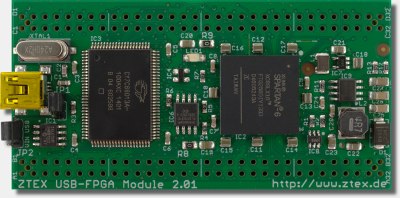 |
Block diagram
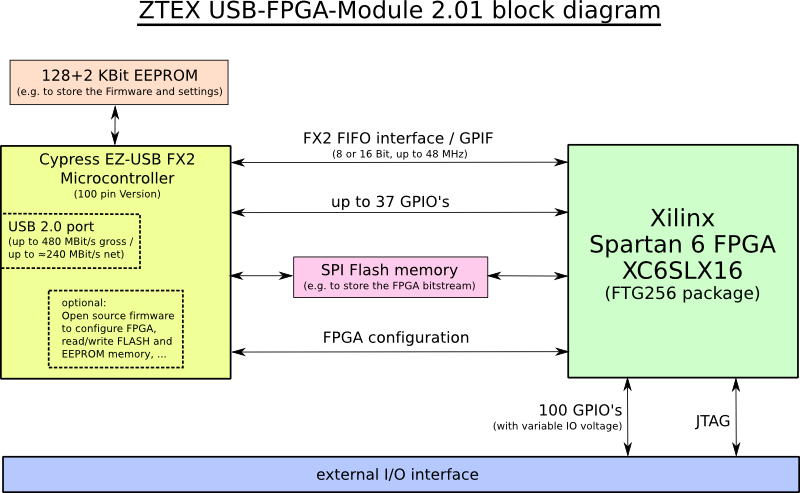
Features
- USB 2.0 interface with Mini-USB connector (B-type)
- Cypress CY7C68013A EZ-USB FX2 Microcontroller (100 pin version)
- Xilinx Spartan 6 XC6SLX16 FPGA (XC6SLX9 and XC6SLX25 on request)
- External I/O connector (consisting in two female 2x32 pin headers with 2.54mm grid) provides:
- 100 General Purpose I/O's (GPIO) connected to FPGA
- JTAG signals
- Reset signal
- External power (4.5 V .. 16 V) input
- 3.3V output
- I/O voltage output or input, see External I/O connector
- 128 MBit on-board Flash memory
- Allows Bitstream loading from Flash to FPGA (up to 6.5 MByte/s)
- Accessible from EZ-USB FX2 and from FPGA
- 128 Kbit EEPROM memory (can be used to store the EZ-USB firmware)
- 2 Kbit MAC-EEPROM: contains a unique non erasable MAC-address and is used to store firmware settings
- On-Board power supply:
- Power source selectable by jumper: USB or External I/O connector
- 3.3 V: 2000 mA
- 1.2 V; 1000 mA
Variants
Three variants with different FPGA's are offered:
| Variant | FPGA | Speed grade (larger means faster) |
Temperature range | Availability |
| USB-FPGA Module 2.01b | XC6SLX16 | 2C | 0-70°C | Sold out. Will not produced anymore due to market situation (lead time of the FPGA is more than 5 years). |
| USB-FPGA Module 2.01c | XC6SLX25 | 2I | -40-85°C | Sold-off, to the shop Will not produced anymore due to market situation (lead time of the FPGA is more than 5 years). |
All variants are supported by the free ISE Webpack versions.
Functional description
The following drawing shows the measurements and the location of the components described here.

Click on the image for a larger version or download the PDF version.
USB-FPGA Modules 2.01 have no mounting holes because they are usually plugged onto an application circuit. Alternatively also one of the add-on cards may be used as mounting adapter.
Common functions of all Series 2 FPGA Boards
USB-FPGA Modules 2.01 belong to ZTEX FPGA Board Series 2. All functions that are shared with the other members of this Series are described on the Series 2 FPGA Board pagePowering, JP2
External power can be supplied via USB or pins A1 and B1 of the external I/O connector. The power source is selected by jumper JP2.If the application circuit uses the 3.3V output of the FPGA Board, current draw form USB may exceed the USB specification.
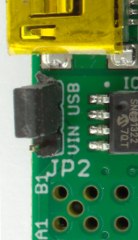
|

|
| JP2: Power supply via USB | JP2: Power supply via VIN pins A1 and B1 of the external I/O connector |
EEPROM address: JP1
Jumper JP1 specifies the I2C address of the EEPROM:
| JP1 | I2C address |
| open | 0xA2 |
| close | 0xAA |
JP1 is used tp prevent Firmware booting from EEPROM, e.g. if the firmware is corrupt. At booting the EZ-USB FX2 Microcontroller expects the firmware at the I2C address 0xA2 (jumper open) and falls back to an internal firmware if no valid data is found at this address (jumper closed).
JP1 has an unconnected pin which can be used for parking the jumper. The following pictures show all possible jumper positions:

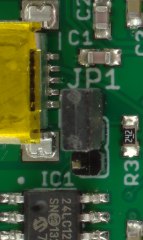
|
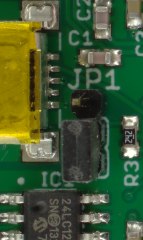
|
| JP1 open | JP1 closed |
FPGA state: LED1
LED1 indicates the configuration state of the FPGA as follows:
| LED1 | FPGA |
| on | unconfigured |
| off | configured |
Clock resources
On USB-FPGA Modules 2.01 two clocks sources are connected to the FPGA: the clock output of the EZ-USB FX2 which is usually configured to 48 MHz and the interface clock which can be configured to 30 MHz or to 48 MHz. They can be used to generate new clocks within the FPGA using DCM's or PLL's.Additional clocks can be connect to the GCLK pins of the I/O connector.
In most cases the on board clock sources are sufficient.
Flash
USB-FPGA Modules 2.01 have 128 MBit SPI Flash memory which can be accessed by the EZ-USB FX2 microcontroller and the FPGA and may serve as configuration memory for the FPGA.The maximum configuration speed is 6.5 Mbyte/s and is achieved at 26 MHz SPI Bus speed and 2 Bit SPI Bus width (bitgen settings -g ConfigRate:26 -g SPI_buswidth:2). Bitstream can be written to the Flash by the SDK via USB (most comfortable) or via JTAG using the indirect programming method of the Xilinx Tools, see ZTEX Wiki
If Flash is not used (CS signal high) the other three SPI pins (DIN, CLK and DOUT) can be used as GPIO pins.
I/O Connector
The external I/O connector is compatible to other FPGA Boards of the Series 2 and therefore described at page of Series 2 FPGA Boards.On USB-FPGA Modules 2.01 all 100 external I/O's are assigned and have a variable I/O voltage. I/O voltage for rows A and B is VCCO_AB and for rows C and D it is VCCO_CD. By default VCCO_AB and VCCO_CD are connected to 3.3V through 0Ω resistors R8 and R9, respectively. Thus, these pins are 3.3V outputs. (This is the standard behaviour for all FPGA Boards of the Series 2.) If another I/O voltage is required, R8 and/or R9 can be unsoldered and VCCO_AB and/or VCCO_CD can be used as voltage input.
USB-FPGA Modules 2.01 have dual entry female pin headers, i.e. user circuits can be connected to both sides. Plugging user PCB's to top side (component side) of the FPGA Board requires non-standard pin headers with long pins. (The pin headers headers which ara available in the Shop can only be used to connect circuits to bottom side).
The pin assignment of USB-FPGA Modules 2.01 and FPGA-Modules 2.00 are equal.
JTAG
The FPGA can be configured either via USB or via JTAG. JTAG signals are available on the external I/O connector and JTAG headers are installed on most add-on cards.
Images
Click on the images for larger versions.
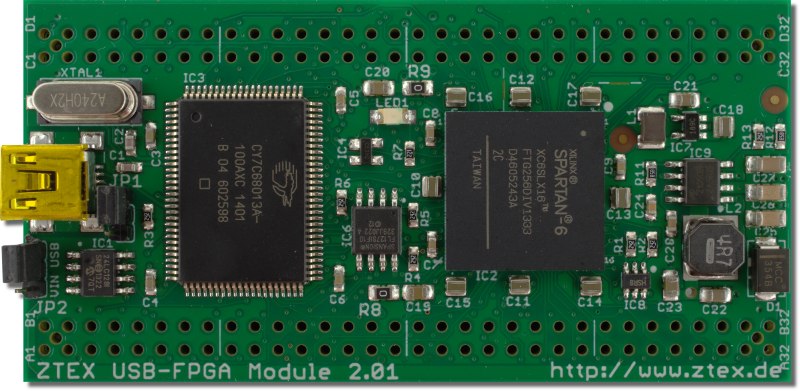
Top side of USB-FPGA Module 2.01b with Spartan 6 XC6SLX16 FPGA. |
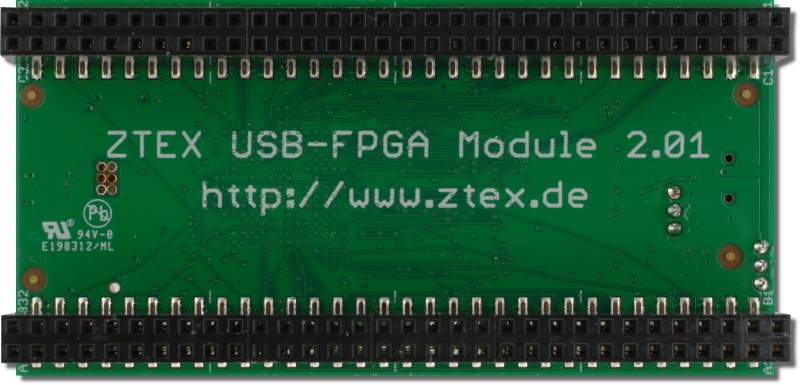
Bottom side of USB-FPGA Module 2.01. |